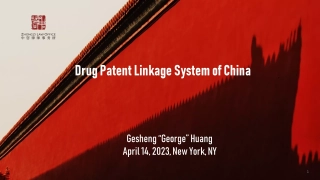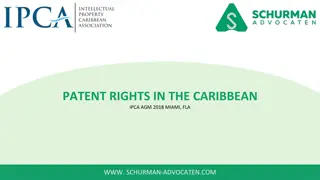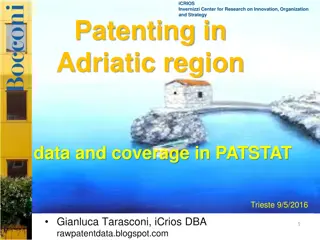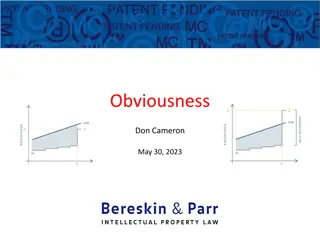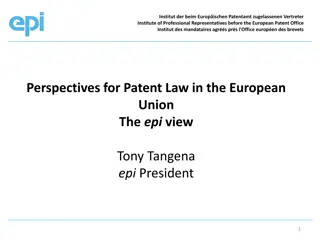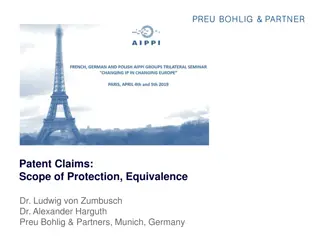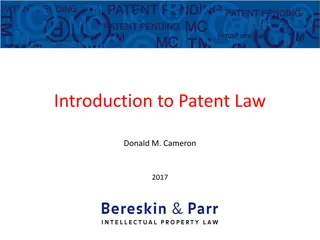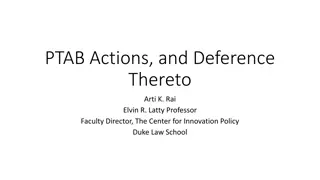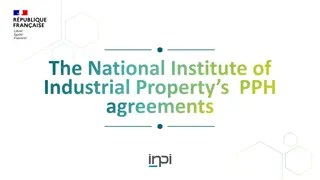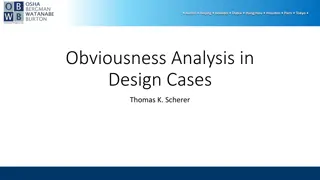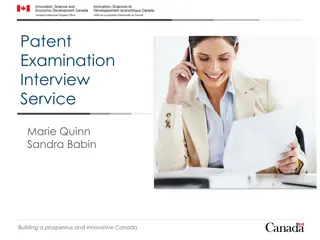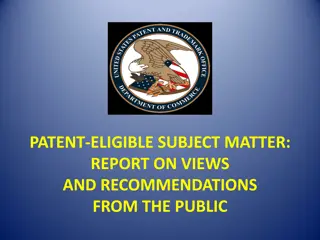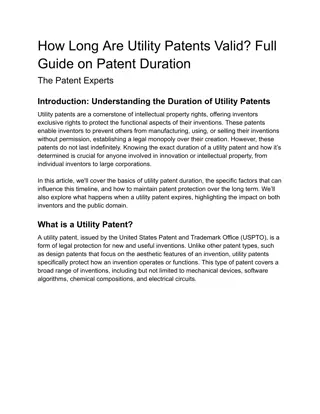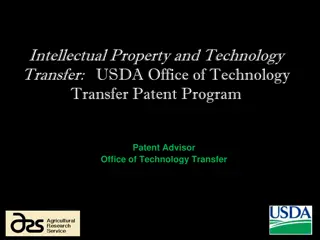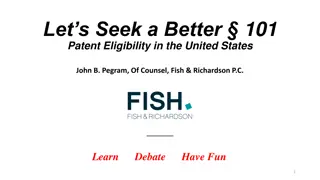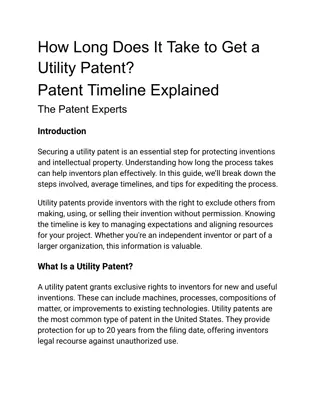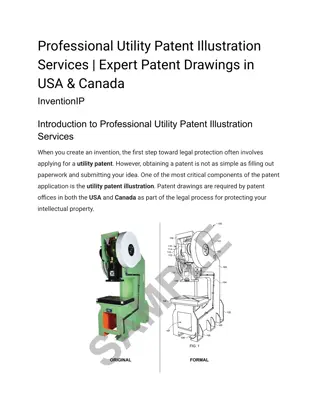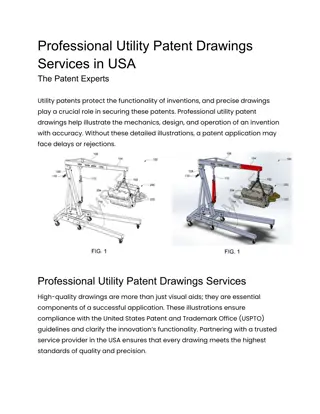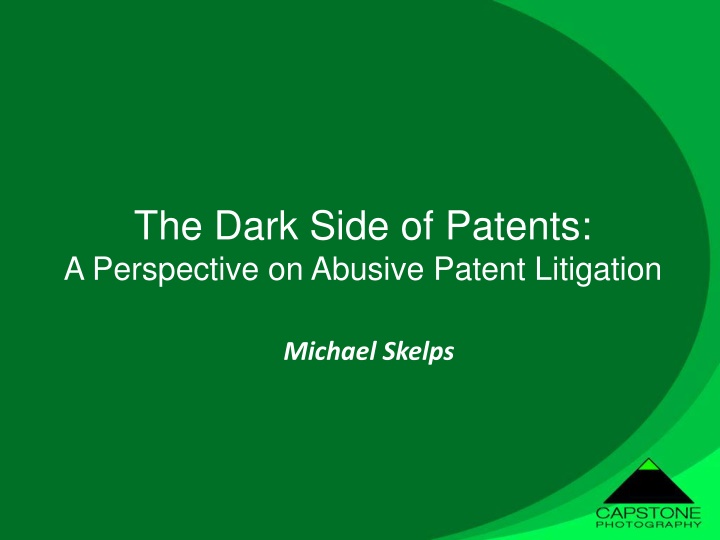
Abusive Patent Litigation and Patent Trolls
Explore the dark side of patents, abusive patent litigation, and patent trolls. Learn about the misuse of broadly interpreted patents for financial intimidation, the history of patent laws, and the impact on innovation. Discover the defining elements of a patent troll and how they operate in the legal landscape.
Download Presentation

Please find below an Image/Link to download the presentation.
The content on the website is provided AS IS for your information and personal use only. It may not be sold, licensed, or shared on other websites without obtaining consent from the author. If you encounter any issues during the download, it is possible that the publisher has removed the file from their server.
You are allowed to download the files provided on this website for personal or commercial use, subject to the condition that they are used lawfully. All files are the property of their respective owners.
The content on the website is provided AS IS for your information and personal use only. It may not be sold, licensed, or shared on other websites without obtaining consent from the author.
E N D
Presentation Transcript
The Dark Side of Patents: A Perspective on Abusive Patent Litigation Michael Skelps
OR How to Make Money on Abusive Patent Litigation
A Little About Myself Navy Nuclear Submarine Officer United Technologies Connecticut Entrepreneur Victim of Abusive Patent Litigation
What is abusive patent litigation? Some call the instigators patent trolls Intentionally vague patents, broadly interpreted, are used as weapons of financial intimidation against businesses, both large and small Began to become a problem in the late 1990s early 2000s
Some Points About Our Patent System In 1474, the first patent law passed in Venice Novelty Usefulness Describe and explain invention Granted inventor exclusive rights to invention 1787, Article I Section 8 of the US constitution
Some Points About Our Patent System Designed to spur genuine innovation by granting a monopoly for a limited time in exchange for the inventor disclosing details of the invention as public information. In the late 1990s, along with the Dot-Com boom, people started patenting simple processes done on a computer . The USPTO wound up granting many new patents for trivial processes. Scan and email Putting a link on a phone app Building a website where you can search for photos
Patent Troll: What is the definition? Stephanie Kennedy, (IP Troll Tracker blog), offers the following identifying elements of a Patent Troll: Can be company or individual Owns Patents which are broadly constructed and interpreted intentionally for the purpose of misuse, and/or as a result of poor USPTO patent examination practices sends threatening letters to companies and/or individuals Demands the user pay license fees Threaten legal action as a means of overt financial intimidation Willing to actually file a lawsuit, the Eastern District of Texas being the most popular venue
Patent Troll: What is the definition? Wikipedia (Pejorative) A person or company that attempts to enforce patent rights against accused infringers far beyond the patent's actual value or contribution to the prior art. Me Someone who uses the broken patent system to conduct legalized extortion
Patent Trolls: How Big is the Problem? Cost on our economy is estimated to be $29-80 billion per year 6,000 patent lawsuits each year 2/3 are considered frivolous or abusive Patent troll lawsuits have grown 500% in the past ten years. This only counts the actual lawsuits Demand Letters cannot be measured currently
Eastern District of Texas Of 94 Federal Court Districts, nearly half of patent cases are held in this single district Judges have actively campaigned EDTX has a plaintiff-friendly venue, including at technology shows The two main judges each has a son that is a patent lawyer in the district Many plaintiffs and defendants don t even have a meaningful presence in this district
Reasons I tell my story Textbook case of abusive patent litigation Simple, easy to understand, easy to relate Promote awareness of this ongoing problem Encourage people to support patent reform legislation
And once the patent was granted Began threatening many photographers the very next day. In 2007, sued 8 photographers in the Eastern District of Texas. Everyone settled. Meanwhile in Connecticut, in 2005 a small business was beginning to grow, unaware of this patent, its owner or the lawsuits. Later, around 2009, three additional patents were granted, which were slight extensions and modifications of the original patent.
March 2008 I left the security of my day job to concentrate on my growing photography venture which was approaching $100,000 in revenue. And then, my phone rang.
March 2008 Attorney suggested waiting for the next official letter before our next steps, which would include an expensive patent re- examination. And we waited. And I concentrated on growing my business.
December 31, 2013 My business had grown to more than $800,000 in revenue. But the market had softened, and our profit was only $30,000. We were looking to reposition for 2014. I had all but forgotten about the patent. The new year rang in. At 12:04 AM, I received an email.
Over the next 10 months Correspondence from the plaintiff s attorney was overtly threatening They spelled out that it cost the typical small business $500K to $1M or more to defend a patent infringement lawsuit. The demand was for $300,000 plus an ongoing license of $125,000. We confirmed this with other patent attorneys and were in disbelief. We contracted a capable patent attorney in California.
Over the next 10 months Plaintiff s attorneys were very aggressive Sued Capstone Photography Inc. Then they sued Michael Skelps Our attorney had a number of potential defenses Divided Infringement Laches Reducing the amount of our revenues that actually infringed on the patent Proving patent was obvious and lacked innovation Proving that others in the industry had done something similar before his patent was filed Problem was that each defense would cost tens of thousands of dollars.
Discovery Process Began Discovery is by far the most expensive and time- consuming part of the patent litigation process. 97 document requests Send every email Send every document Many of these documents didn t even exist Everything we provided was deemed unsatisfactory And the legal bills began racking up
June 2014, U.S. Supreme Court Alice vs. CLS bank. Lawsuit involved patent on a financial transaction performed on a computer system involving a third party escrow Supreme Court found the patent was ineligible subject matter for a patent Generic process of routine steps Implemented on a generic computer Lacked sufficient inventive concept
And the pressure continued mounting Plaintiff s attorney demanded we cease all infringing activities We felt like we couldn t market or grow We laid off three employees
Mediation was unsuccessful My wife and I flew to California to meet with the plaintiff for court-required mediation Again, attorneys were very aggressive and personally intimidating Despite a very significant cash offer which was made, the plaintiff rejected, and we marched on to a jury trial I never could have signed it
Ineligible subject matter My attorney suggested the quickest and least expensive option was to file a Motion for Judgment on the Pleadings stating that the patents were ineligible under the Alice precedent. This would circumvent the discovery process, which I knew I could not afford. We bet the company on this Motion. My attorney said that it was a real long shot to think that the judge would invalidate 81 claims in three patents in a single ruling.
October 28, 2014 After more than 15 year since the initial patent application, this was the first time that a judge actually ruled on the case. The judge issued a 26-page, single spaced ruling that relied heavily on the Alice ruling. The ruling was 100% in my favor. All three patents were invalidated in their entirety. After 30 days, the plaintiff s window to appeal the ruling closed. We had won.
The toll on my business $100,000 in legal expenses 10 months where we could not grow or market Sleepless nights, disruption to family 3 jobs eliminated This did not feel like a victory.
Patent Reform Legislation HR-9 (The Innovation Act) S-1137 (The PATENT Act) Concentrated on four areas of patent reform: Venue reform Limiting discovery until infringement was confirmed Heightened pleading standards Fee-shifting Both bills were overwhelmingly approved in Judiciary Committee Both bills have stalled.
My Lobbying Efforts In 2015, I traveled four times to Washington DC and met with the offices of more than 70 Congressmen and Senators to tell my story and to ask them to support these two bills. Opponents to patent reform include: Universities Pharmaceutical Biotech
Short-term forecast With the impending election, patent reform is almost certainly dead for the balance of 2016. Will have to restart legislation in the next Congress in January.
Things to keep in mind General & Liability Insurance affords no protection to the innocent small business who is forced to defend a patent infringement lawsuit Alice may slightly reduce the odds of a favorable outcome for a patent troll, but the incentive remains. We still need patent reform passed in Congress
What can you do? Sadly, not much. Stand your ground. Refuse to settle. Hope that Alice is effective as legal defense. Join the LOT Network Non-profit organization which provides immunity from patents owned by existing LOT members, should they fall into the hands of a patent troll. Patent Troll Insurance (starts at $7500/year with $25,000 deductible. $1 million limit.) TELL YOUR CONGRESSMEN TO SUPPORT PATENT REFORM!

